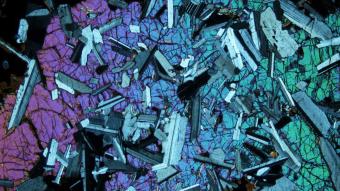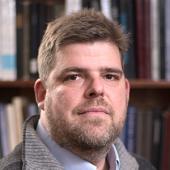What’s the carbon sequestration potential of copper, nickel and platinum ore deposits? Mines-led project to help mining companies do the math
Cross-disciplinary team at Colorado School of Mines, Virginia Tech received $1.15M in funding from ARPA-E

This thin section of a mafic rock, shown under cross-polarized light, came from the Duluth Complex, one of the world’s largest undeveloped deposits of copper, nickel and platinum metals. (Image by Erik Tharalson)
Researchers at Colorado School of Mines and Virginia Tech have been awarded $1.15 million by the U.S. Department of Energy for research that will aid in the development of new technology that will enable mining companies to quantitatively model the carbon sequestration potential of copper-nickel-platinum-group element ore deposits.
Led by Thomas Monecke, professor of geology and geological engineering at Mines, the project is receiving funding from the DOE’s Advanced Research Projects Agency-Energy (ARPA‑E) Mining Innovations for Negative Emissions Resource Recovery (MINER) program. MINER funds technology development and research that increases the mineral yield and domestic supply of copper, nickel, cobalt, and other critical elements, while decreasing the required energy – and subsequent emissions – to mine and extract these energy-relevant minerals.

“This is a great opportunity to demonstrate and advance our collective expertise in the geology and mineralogy of ore deposits and carbon sequestration,” Monecke said. “We have assembled a team of experts from Colorado School of Mines and Virginia Tech to develop a technological solution that will allow mining companies to quantitatively evaluate whether adaption of net-zero or net-negative emission technology is economically feasible. We envision that this evaluation could become an integral part of feasibility studies that mining companies conduct prior to making an investment decision.”
“I’ve been studying CO2 storage in CO2-reactive rocks since I was a graduate student, so it’s very exciting to be part of a team that will bring this into the mining sector,” said Ryan Pollyea, associate professor in the Department of Geosciences and affiliate faculty in the Department Mining and Minerals Engineering at Virginia Tech.
For this project, the research team at Mines and Virginia Tech will work closely with industry partner MINALYZE AB, a provider of cutting-edge continuous X-ray fluorescence core scanning technology. Based on the geochemical analysis of drill core, the research team will devise machine-learning algorithms that will allow quantification of the relative proportions of CO2-reactive minerals contained in the core.
A thermodynamic modeling algorithm will then be developed that determines the amount of CO2 that can be sequestered into rock formations of variable mineralogy. As a final step, the research team will develop a methodology for block modeling to determine the total amount of CO2 that could be sequestered into an entire ore deposit hosted in mineralogically heterogeneous host rocks.
The work to be performed will combine expertise in ore deposit geology, petrology and mineralogy, and thermodynamics and carbon sequestration with spatial subsurface modeling and mining engineering.
“Colorado School of Mines and Virginia Tech are really well positioned to be significant players in boosting domestic critical mineral supplies while deploying net-zero or net-negative emission technologies in the mining sector,” said co-PI Katharina Pfaff, research associate professor at Mines. “Over the past years we have built strong ties between both universities allowing us to tackle a range of use-inspired research problems that mining companies face.”
Co-PI Erik Westman, professor at Virginia Tech, added: “It is particularly exciting for me as a mining engineer to contribute to a project that has the potential to transform the way we evaluate the feasibility of a mining operation by considering how much CO2 can be sequestered into ore and waste. This is an important project as it is at the forefront of green mining."




